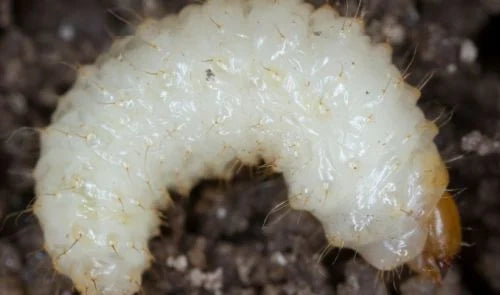Nematodes - Organic Pest Control for Leatherjackets and Chafer Grubs
Organic pest control comes in many forms, as the UK's trusted and leading supplier of nematodes we're pleased to reassure you that all nematodes are safe to children, pets and wildlife.
Buy nematodes for organic pest control today - benefit from FREE UK delivery when ordering just nematodes or £4.98 per order when ordering other products.
What are Leatherjackets
Leatherjackets are the legless greyish-brown larvae of the crane fly (daddy long legs). Eggs are laid in August, the larvae then start feeding on grass roots from September through to the following Spring.
Larvae may move into flower beds. Plants are weakened and less drought resistant
Identifying Leatherjacket Damage
Damage to lawns occurs from Autumn to Spring. Grass starts yellowing and becomes weak where the roots have been damaged. The grass can be easily pulled up with little or no root growth. Damage is usually more severe when we experience a mild wet Autumn.
Secondary damage can also be caused by birds and mammals digging up turf in their search for leatherjackets. Adult crane flies hatch from pupae in late July and August and lay their eggs in the ground within 24 hours of hatching.
The larvae hatch about 2 weeks later and start to feed on grass roots, which continues through winter and into spring. The larvae are greyish brown and are legless.
How and When to Apply Leatherjacket Nematodes
Leatherjacket nematodes are best applied from late August to October, if infestations are high apply April/May time too.
Apply the nematodes to moist lawns when the soil temperature is above 10ºC. Always follow the instructions on the packet. Ensure you water the lawn again after application to get the nematodes to the roots of the grass where the larvae are. Keep moist for at least 2 weeks.
The nematodes (Steinernema feltiae), seek out the leatherjackets larvae and enter natural body openings. Once inside, the larvae start to die
What Are Chafer Grubs?
Chafer grubs are the larvae of chafer beetles. Chafer beetles lay eggs in lawns and grassland areas during July, these eggs hatch into larvae which cause the damage to lawns by feeding on the roots.
Chafer nematodes will attack these grubs giving a high degree of control.
Identifying Chafer Grub Lawn Damage
If chafer grubs are present, the lawn may develop patches which become yellowish, birds, badgers and foxes tear up the lawn to get to the grubs to feed on them.
Chafer grubs can be found in the soil under the loose turf. They are white and curved with light brown heads, with three pairs of legs at the head end. Similar damage to lawns can be caused by leatherjackets but the birds and animals are less likely to tear up the lawn to find them.
What and How do Nematodes Kill Chafer Grubs
Chafer nematodes work by seeking out the chafer beetle larvae they then enter natural body openings, once inside the chafer grub dies quite quickly.
Applying Chafer Killer Nematodes
Just mix with water according to the instructions and water on. Chafer Grub Killer should be applied to a moist lawn. Ideally apply after the sun has gone down so the ground will not dry out so quickly. For maximum efficiency keep the soil moist.
Which months are best to treat chafer grubs with nematodes?
The optimum time to apply chafer nematodes is from late July until the beginning of September Storage. The unopened pack may be stored in the fridge until the expiry date this is usually about 2 weeks. Once the pack is opened it should be used immediately.
